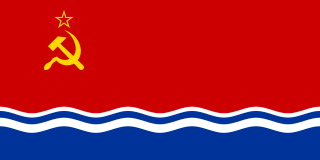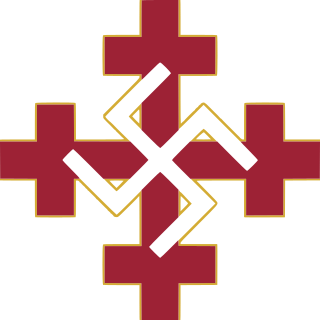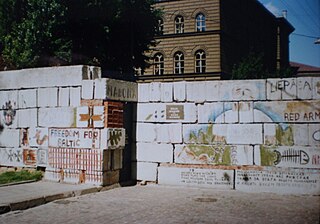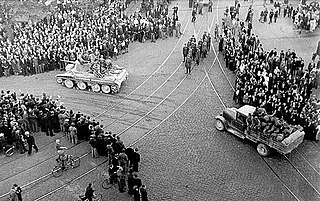
The Singing Revolution was a series of events from 1987 to 1991 that led to the restoration of independence of the three Soviet-occupied Baltic countries of Estonia, Latvia, and Lithuania at the end of the Cold War. The term was coined by an Estonian activist and artist, Heinz Valk, in an article published a week after the 10–11 June 1988 spontaneous mass evening singing demonstrations at the Tallinn Song Festival Grounds.

The Latvian Soviet Socialist Republic was de facto one of the constituent republics of the Soviet Union between 1940–1941 and 1944–1990.

Kārlis Augusts Vilhelms Ulmanis was a Latvian politician and a dictator. He was one of the most prominent Latvian politicians of pre-World War II Latvia during the Interwar period of independence from November 1918 to June 1940 and served as the country's first prime minister.

The Popular Front of Latvia was a political organisation in Latvia in the late 1980s and early 1990s which led Latvia to its independence from the Soviet Union. It was similar to the Popular Front of Estonia and the Sąjūdis movement in Lithuania.

Pērkonkrusts was a Latvian ultranationalist, anti-German, anti-Slavic, and antisemitic political party founded in 1933 by Gustavs Celmiņš, borrowing elements of German nationalism—but being unsympathetic to Nazism at the time—and Italian Fascism. It was outlawed in 1934, its leadership arrested, and Celmiņš eventually exiled in 1937. Still-imprisoned members were persecuted under the first Soviet occupation; some collaborated with subsequently invading Nazi Germany forces in perpetrating the Holocaust. Pērkonkrusts continued to exist in some form until 1944, when Celmiņš, who had initially returned to work in the occupying German administration, was imprisoned.
The modern Latvian independence movement was the resistance movement to foreign occupation of the Republic of Latvia during Soviet and Nazi German occupation (1940–1991).

The Baltic Way or Baltic Chain was a peaceful political demonstration that occurred on 23 August 1989. Approximately two million people joined their hands to form a human chain spanning 690 kilometres (430 mi) across the three Baltic states of Estonia, Latvia and Lithuania, which at the time were occupied and annexed by the USSR and had a combined population of approximately eight million. The central government in Moscow considered the three Baltic countries constituent republics of the Soviet Union.
Many Latvians resisted the occupation of Latvia by Nazi Germany. Independent Latvia had been occupied by the Soviet Union in June 1940, then by Nazi Germany in July 1941, forming Generalbezirk Lettland. The Latvian resistance movement was divided between the pro-independence units under the Latvian Central Council and the pro-Soviet units under the Central Staff of the Partisan Movement in Moscow. Daugavpils was the scene of fierce Jewish resistance during the Holocaust. Many local Latvians were actively involved in the resistance movement against the ethnic policies of the German occupation regime. 134 Latvians were later honored with the title Righteous Among the Nations, among them is Žanis Lipke, who risked his life to save more than 50 Jews.

The Latvian National Theatre is one of the leading professional theatres in Latvia. The building is in the eclectic style and is an architectural and artistic monument. The country of Latvia was proclaimed in this building in the year 1918. On 23 February 2002, the theatre celebrated its 100th anniversary. The director of National Theatre of Latvia since 2006 has been Ojārs Rubenis.

The Freedom Monument is a monument located in Riga, Latvia, honouring soldiers killed during the Latvian War of Independence (1918–1920). It is considered an important symbol of the freedom, independence, and sovereignty of Latvia. Unveiled in 1935, the 42-metre (138 ft) high monument of granite, travertine, and copper often serves as the focal point of public gatherings and official ceremonies in Riga.

Vilis Lācis was a Latvian writer and communist politician.

The Barricades were a series of confrontations between the Republic of Latvia and the Union of Soviet Socialist Republics in January 1991 which took place mainly in Riga. The events are named for the popular effort of building and protecting barricades from 13 January until about 27 January. Latvia, which had declared restoration of independence from the Soviet Union a year earlier, anticipated that the Soviet Union might attempt to regain control over the country by force.
Sovetskaya Latviya was a major Russian-language newspaper in the Latvian SSR.

The Soviet occupation of Latvia in 1940 refers to the military occupation of the Republic of Latvia by the Soviet Union under the provisions of the 1939 Molotov–Ribbentrop Pact with Nazi Germany and its Secret Additional Protocol signed in August 1939. The occupation took place according to the European Court of Human Rights, the Government of Latvia, the United States Department of State, and the European Union. In 1989, the USSR also condemned the 1939 secret protocol between Nazi Germany and herself that had led to the invasion and occupation of the three Baltic countries, including Latvia.

The Museum of the Occupation of Latvia is a museum and historic educational institution located in Riga, Latvia. It was established in 1993 to exhibit artifacts, archive documents, and educate the public about the 51-year period in the 20th century when Latvia was successively occupied by the USSR in 1940–1941, then by Nazi Germany in 1941–1944, and then again by the USSR in 1944–1991. Official programs for visits to Latvia of top level representatives of other countries normally include a visit to the Museum of the Occupation.

The three Baltic states – Estonia, Latvia and Lithuania – were re-occupied in 1944–1945 by the Soviet Union (USSR) following the German occupation. The Baltic states regained independence in 1990–1991.

Latvia's Independence Day, officially known as the Proclamation Day of the Republic of Latvia, is celebrated annually on 18 November in Latvia. It marks the anniversary of the Proclamation of Independence of Latvia by the People's Council of Latvia in 1918.

The Union of Soviet Socialist Republics (USSR) was formally dissolved as a sovereign state and subject of international law on 26 December 1991 by Declaration № 142-Н of the Soviet of the Republics of the Supreme Soviet of the Soviet Union. It also brought an end to the Soviet Union's federal government and General Secretary Mikhail Gorbachev's effort to reform the Soviet political and economic system in an attempt to stop a period of political stalemate and economic backslide. The Soviet Union had experienced internal stagnation and ethnic separatism. Although highly centralized until its final years, the country was made up of 15 top-level republics that served as the homelands for different ethnicities. By late 1991, amid a catastrophic political crisis, with several republics already departing the Union and Gorbachev continuing the waning of centralized power, the leaders of three of its founding members, the Russian, Belorussian, and Ukrainian SSRs, declared that the Soviet Union no longer existed. Eight more republics joined their declaration shortly thereafter. Gorbachev resigned on 25 December 1991 and what was left of the Soviet parliament voted to dissolve the union.
Linards Grantiņš is a Latvian former human rights activist who was among the founders of the Latvian human rights activist group Helsinki-86 in 1986.
Konstantīns Pupurs was a Latvian political scientist, historian, linguist and human rights group "Helsinki-86" activist during the Latvian Third Awakening, also known as the Singing Revolution. Since 2010 he became active in the Latvian political movement "All For Latvia!".














